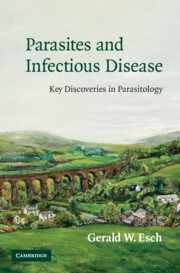Book contents
- Frontmatter
- Contents
- Preface
- Prologue
- 1 African trypanosomes and their VSGs
- 2 Malaria: the real killer
- 3 The HIV–AIDS vaccine and the disadvantage of natural selection: the yellow fever vaccine and the advantage of artificial selection
- 4 Lyme disease: a classic emerging disease
- 5 The discovery of ivermectin: a ‘crapshoot’, or not?
- 6 “You came a long way to see a tree”
- 7 Infectious disease and modern epidemiology
- 8 The ‘unholy trinity’ and the geohelminths: an intractable problem?
- 9 Hookworm disease: insidious, stealthily treacherous
- 10 The spadefoot toad and Pseudodiplorchis americanus: an amazing story of two very aquatic species in a very dry land
- 11 The schistosomes: split-bodied flukes
- 12 Dicrocoelium dendriticum and Halipegus occidualis: their life cycles and a genius at work
- 13 Trichinosis and Trichinella spp. (all eight of them, or is it nine?)
- 14 Phylogenetics: a contentious discipline
- 15 Toxoplasma gondii, Sarcocystis neurona, and Neospora caninum: the worst of the coccidians?
- Summary
- Index
- References
12 - Dicrocoelium dendriticum and Halipegus occidualis: their life cycles and a genius at work
Published online by Cambridge University Press: 24 November 2009
- Frontmatter
- Contents
- Preface
- Prologue
- 1 African trypanosomes and their VSGs
- 2 Malaria: the real killer
- 3 The HIV–AIDS vaccine and the disadvantage of natural selection: the yellow fever vaccine and the advantage of artificial selection
- 4 Lyme disease: a classic emerging disease
- 5 The discovery of ivermectin: a ‘crapshoot’, or not?
- 6 “You came a long way to see a tree”
- 7 Infectious disease and modern epidemiology
- 8 The ‘unholy trinity’ and the geohelminths: an intractable problem?
- 9 Hookworm disease: insidious, stealthily treacherous
- 10 The spadefoot toad and Pseudodiplorchis americanus: an amazing story of two very aquatic species in a very dry land
- 11 The schistosomes: split-bodied flukes
- 12 Dicrocoelium dendriticum and Halipegus occidualis: their life cycles and a genius at work
- 13 Trichinosis and Trichinella spp. (all eight of them, or is it nine?)
- 14 Phylogenetics: a contentious discipline
- 15 Toxoplasma gondii, Sarcocystis neurona, and Neospora caninum: the worst of the coccidians?
- Summary
- Index
- References
Summary
Earth knows no desolation.
She smells regeneration.
In the moist breath of decay.
‘Ode to the spirit of earth in autumn’, George Meredith (1828–1913)One of the best parasitologists in the early part of the twentieth century for making discoveries involving parasite life cycles was Wendell Krull. The late, and great, Miriam Rothschild referred to him as “a genius who hid his light under a bushel” (Ewing, 2001). Part of her admiration for Krull stemmed from his research on the life cycle of Halipegus occidualis, the hemiurid fluke that lives under the tongues of North American ranid frogs. Others might consider him as a genius for his contribution in resolving the life cycle of Dicrocoelium dendriticum.
Wendell Krull is now dead, so I had to rely on other resources for special information regarding his career and some of the research he accomplished. In addition to a number of Krull's papers, one of the important biographical sources for this effort was a book written by Sidney Ewing, entitled Wendell Krull: Trematodes and Naturalists, published in 2001. It really is a delightful read. Over a period of eleven years, including his three years as a graduate student, Sidney had many conversations with Krull regarding his life's work. I have unashamedly quoted from Ewing's book throughout the essay. I also had the wonderful opportunity of interviewing Sidney Ewing and his wife, Margaret, who provided me with even more insights regarding Krull, including Margaret's experience in Krull's veterinary parasitology course at Oklahoma State University.
- Type
- Chapter
- Information
- Parasites and Infectious DiseaseDiscovery by Serendipity and Otherwise, pp. 282 - 298Publisher: Cambridge University PressPrint publication year: 2007

